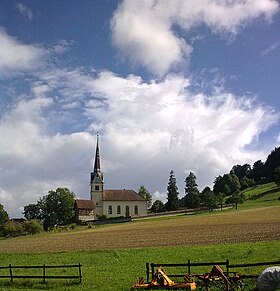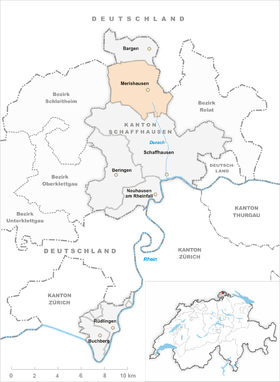Merishausen
| Merishausen | |
|---|---|
| State : |
|
| Canton : |
|
| District : | Schaffhausen |
| BFS no. : | 2936 |
| Postal code : | 8232 |
| Coordinates : | 687 781 / 290671 |
| Height : | 533 m above sea level M. |
| Height range : | 487–912 m above sea level M. |
| Area : | 17.56 km² |
| Residents: | 859 (December 31, 2018) |
| Population density : | 49 inhabitants per km² |
| Website: | www.merishausen.ch |
|
Church of Merishausen (SH), August 2010 |
|
| Location of the municipality | |
Merishausen is a municipality in the canton of Schaffhausen in Switzerland .
geography
Merishausen is located about 7 km north of the canton capital Schaffhausen in the Merishausertal , nestled between seven hills. The Durach flows through the village . In the area of Merishausen lies the Hagen , part of the Randen and with 912 m. ü. M. highest point in the canton of Schaffhausen .
The border between Germany and Switzerland runs northwest .
history
It is uncertain in which year Merishausen was founded. It has been proven that the Merishausertal has been inhabited since the Neolithic Age (approx. 2000 BC) through the Bronze and Iron Ages . This is also evidenced by some archaeological finds that can be viewed in the Museum zu Allerheiligen in Schaffhausen.
Merishausen only became an actual settlement when the Alemanni settled down in the 4th century. From the year 496 Merishausen came under Franconian rule and belonged to the Landgraviate of the Nellenburger . Christianization began at this time. The church was built between the 6th and 8th centuries. It is the earliest documented church in the entire canton of Schaffhausen. The name "Merishausen" comes from the Alemanni and may have been derived from the name of a progenitor or clan chief. The oldest spelling is "Morinishusum" which means "in the houses of Morin or Maurin" .
In the year 846 Merishausen was Count Liutolt from Scheer near Sigmaringen on the Danube "the Huben his own church to Morinishusun the monastery of St. Gallen with a Hube country Berslingen vergabt". This is also the first documentary mention of Merishausen. From its foundation in 1050, the Allerheiligen monastery also acquired real estate in the Merishausertal. The abbot barn at the foot of the Längenberg was built to store grain and fodder, and in 1588 it was relocated and enlarged in the middle of the valley.
The hospital's first purchase of land dates back to 1273. In the following centuries the number of acquisitions increased so much that in 1724 the hospital property comprised 430 Jucharten arable land. According to the "opening" law of 1470, the monastery and the hospital jointly set up a bailiff to monitor the land and people . This exercised together with some free villagers at the same time the lower jurisdiction . After the Reformation in the 16th century, Merishausen was ceded to the city of Schaffhausen by the last abbot of the Allerheiligen monastery. The whole landscape was divided into 10 upper bailiffs. Merishausen belonged with barges to the seventh bailiwick. The Obervogt, who supervised this district, was a member of the small council and had his seat in Schaffhausen.
The corpses were a heavy burden for the Merishauser. The farmers had to bring the wood from the city's forests to the city for a small fee. Roads and community buildings were also built by labor . The strict regulations governing trade in agricultural products were also a major restriction for the farmers. In such times, the emigration propaganda at the beginning of the 18th century had to fall on favorable ground. After his return from Pennsylvania, Hans Jerg Wehrner did advertising work. This caused 54 people to emigrate from Merishausen to Pennsylvania and Carolina between 1738 and 1751 . Again, in the 1950s and 1970s, emigration increased. The population of the village had increased from 1799 to 1836 from 674 to 961 people. The closure of the border in Bargen to Baden and the fragmentation of the properties by dividing inheritance led to a poor time. Over 300 people emigrated to America between 1842 and 1882.
In 1839 the community finally bought itself out of the city of Schaffhausen. From then on, the division of the population into an urban upper class and a rural subjugation was forever abolished. The Postbus has been traveling to Merishausertal since July 11, 1921 . The day before the stagecoach had made its last trip.
| Population development | ||||||||
|---|---|---|---|---|---|---|---|---|
| year | 1771 | 1798 | 1850 | 1950 | 2000 | |||
| Residents | 467 | 674 | 932 | 539 | 644 | |||
coat of arms
- A yellow six-pointed star in blue.
In the 16th century, the Merishausen coat of arms was adorned with a blue star on a gold background. This motif was probably forgotten, because when the community put a seal on it in the 18th century , there was a ploughshare on it , which is surrounded by two crossed tendrils at the bottom. The ploughshare was used from then on. During the adjustment in 1949, however, in order to avoid confusion, the historically proven representation with the star in wrong colors was used.
traffic
Merishausen is located on the main road 4 from Schaffhausen to Bargen . It currently leads past Merishausen without any interchanges. However, a half connection is planned.
Attractions
Merishausen is considered an Alemannic line village . Houses built in the original style of the Alemanni are lined along the main street. The stable for pets is on the ground floor and the living rooms are on the first floor.
gallery
Personalities
- Carl August Bächtold (1838–1921), pastor and historical researcher
literature
- Urs Leu: Merishausen. History of a Randengemeinde , Merishausen 1996, ISBN 3-8580-111-50 .
- Jost Bürgi: Traces of settlement in the Latène period near Merishausen SH , in: Archeology of Switzerland, 5, 1982, pp. 105–109.
- Markus Höneisen: The Latène Age settlement finds of Merishausen-Barmen (SH) , in: Yearbook of the Swiss Society for Pre- and Early History, 72, 1989, pp. 99–126.
- Urs Leu: On the history of viticulture in Merishausen , in: Schaffhauser contributions to history, 63, 1986, pp. 153–163.
Web links
- Official website of the municipality of Merishausen
- Ulf Wendler: Merishausen. In: Historical Lexicon of Switzerland .
Individual evidence
- ↑ Permanent and non-permanent resident population by year, canton, district, municipality, population type and gender (permanent resident population). In: bfs. admin.ch . Federal Statistical Office (FSO), August 31, 2019, accessed on December 22, 2019 .
- ↑ Presentation of the local history on the website of the municipality of Merishausen
- ↑ Ulf Wendler: Merishausen. In: Historical Lexicon of Switzerland . October 31, 2008 , accessed June 12, 2019 .
- ^ Bruckner-Herbstreit, Berty: The emblems of the state of Schaffhausen and its communities, Reinach-Basel 1951, pp. 229–230.











